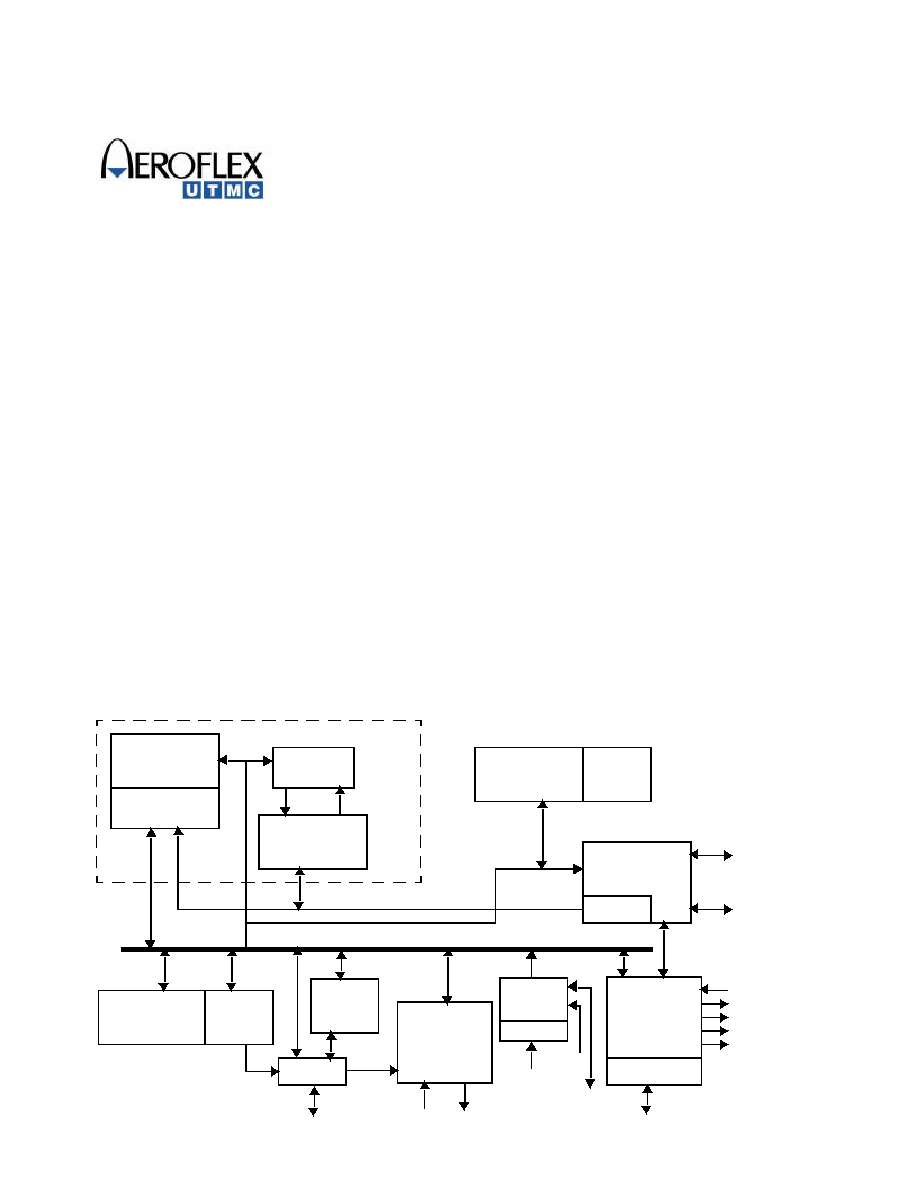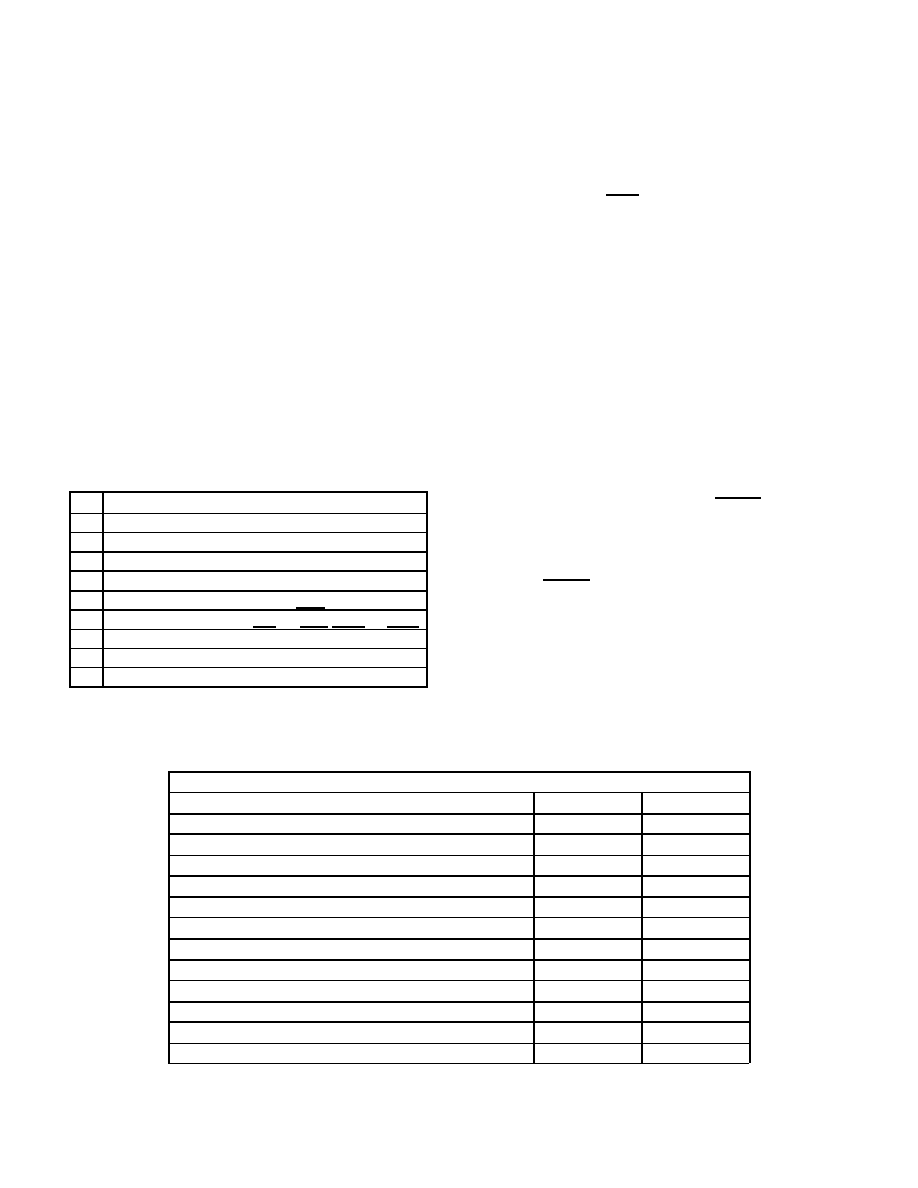
FEATURES
q 20MHz 16-bit Microcontroller compatible with industry
standard's MCS-96 ISA
- Register to Register Architecture
- 1000 Byte Register RAM
q Three 8-bit I/O Ports
q On-board Interrupt Controller
q Three Pulse-Width Modulated Outputs
q High Speed I/O
q UART Serial Port
q Dedicated Baud Rate Generator
q Software and Hardware Timers
- 16-Bit Watchdog Timer, Four 16-Bit Software Timers
- Three 16-Bit Counter/Timers
q Radiation-hardened process and design; total dose
irradiation testing to MIL-STD-883 Method 1019
- Total-dose: 100K rads(Si)
- Effective LET threshold: 25 MeV-cm
2
/mg
- Saturated cross section: 3.66e-7cm
2
/bit
- Latchup immune (LET > 128 MeV-cm
2
/mg)
q Error detection and correction for external memory accesses
q QML Q and QML V compliant part
q Standard Microcircuit Drawing 5962-98583
INTRODUCTION
The UT80CRH196KD is compatible with industry standard's
MCS-96 instruction set. The UT80CRH196KD is supported
by commercial hardware and software development tools.
Built on UTMC's Commercial RadHard
TM
epitaxial CMOS
technology, the microcontroller is hardened against ionizing
dose and charged particles. The microcontroller's on-board
1000 byte scratch-pad SRAM and flip-flops can withstand
charged particles with energies up to 25 MeV-cm
2
/mg.
The UT80CRH196KD accesses instruction code and data via
a 16-bit address and data bus. The 16-bit bus allows the
microcontroller to access 128K bytes of instruction/data
memory. Integrated software and hardware timers, high speed
I/O, pulse width modulation circuitry, and UART make the
UT80CRH196KD ideal for control type applications. The
CPU's ALU supports byte and word adds and subtracts, 8 and
16 bit multiplies, 32/16 and 16/8 bit divides, as well as
increment, decrement, negate, compare, and logical
operations. The UT80CRH196KD's interrupt controller
prioritizes and vectors 18 interrupt events. Interrupts include
normal interrupts and special interrupts. To reduce power
consumption, the microcontroller supports software invoked
idle and power down modes. The UT80CRH196KD is
packaged in a 68-lead quad flatpack.
1000 Bytes
RAM
Register File
ALU
MicroCode
Engine
Interrupt
Controller
PTS
Memory
Controller
Queue
Watchdog
Timer
PWM
PORT2
Serial
Port
HSIO and
Timers
HSI HSO
Alternate
Functions
CPU
Alternate
Functions
PORT1
HOLD
HLDA
BREQ
PWM1
PWM2
Control
Signals
Address /Data Bus
Figure 1. UT80CRH196KD Microcontroller
Fi
rs
tP
as
s
Co
re
IP
PORT0
EXTINT
ECB0-
ECB5
Standard Products
UT80CRH196KD Microcontroller
Datasheet
September, 2002

2
1.0 SIGNAL DESCRIPTION
Port 0 (P0.0 - P0.7): Port 0 is an 8-bit input only port when used
in its default mode. When configured for their alternate function,
five of the bits are bi-directional EDAC check bits as shown in
Table 1.
Port 1 (P1.0 - P1.7): Port 1 is an 8-bit, quasi-bidirectional, I/O
port. All pins are quasi-bidirectional unless the alternate
function is selected per Table 2. When the pins are configured
for their alternate functions, they act as standard I/O, not quasi-
bidirectional.
Port 2 (P2.0 - P2.7): Port 2 is an 8-bit, multifunctional, I/O port.
These pins are shared with timer 2 functions, serial data I/O and
PWM0 output, per Table 3.
AD0-AD7: The lower 8-bits of the multiplexed address/data
bus. The pins on this port are bidirectional during the data phase
of the bus cycle.
AD8-AD15: The upper 8-bits of the multiplexed address/data
bus. The pins on this port are bidirectional during the data phase
of the 16-bit bus cycle. When running in 8-bit bus width, these
pins are non-multiplexed, dedicated upper address bit outputs.
HSI: Inputs to the High Speed Input Unit. Four HSI pins are
available: HSI.0, HSI.1, HSI.2, and HSI.3. Two of these pins
(HSI.2 and HSI.3) are shared with the HSO Unit. Two of these
pins (HSI.0 and HSI.1) have alternate functions for Timer 2.
HSO: Outputs from the High Speed Output Unit. Six HSO pins
are available: HSO.0, HSO.1, HSO.2, HSO.3, HSO.4, and
HSO.5. Pins HSO.4 and HSO.5 are shared with pins HSI.2 and
HSI.3 of the HSI Unit respectively.
Table 1. Port 0 Alternate Functions
Port Pin
Alternate
Name
Alternate Function
P0.0-P0.3,
P0.6
ECB0-ECB4 Error Detection & Correction
Check Bits
P0.4
P0.5
Input Port Pins
P0.7
EXTINT
Setting IOC1.1=1 will allow P0.7
to be used for EXTINT (INT07)
Table 2. Port 1 Alternate Functions
Port
Pin
Alternate
Name
Alternate Function
P1.0
P1.0
I/O Pin
P1.1
P1.1
I/O Pin
P1.2
P1.2
I/O Pin
P1.3
PWM1
Setting IOC3.2=1 enables P1.3 as
the Pulse Width Modulator
(PWM1) output pin.
P1.4
PWM2
Setting IOC3.3=1 enables P1.4 as
the Pulse Width Modulator
(PWM2) output pin.
P1.5
BREQ
Bus Request, output activated
when the bus controller has a
pending external memory cycle.
P1.6
HLDA
Bus Hold Acknowledge, output
indicating the release of the bus.
P1.7
HOLD
Bus Hold, input requesting control
of the bus.
Table 3. Port 2 Alternate Functions
Port
Pin
Alternate
Name
Alternate Function
P2.0
TXD
Transmit Serial Data.
P2.1
RXD
Receive Serial Data.
P2.2
EXTINT
External interrupt. Clearing
IOC1.1 will allow P2.2 to be
used for EXTINT (INT07)
P2.3
T2CLK
Timer 2 clock input and Serial
port baud rate generator input.
P2.4
T2RST
Timer 2 Reset
P2.5
PWM0
Pulse Width Modulator
output 0
P2.6
T2UP-DN
Controls the direction of the
Timer 2 counter. Logic High
equals count down. Logic low
equals count up.
P2.7
T2CAPTURE
A rising edge on P2.7 causes
the value of Timer 2 to be
captured into this register, and
generates a Timer 2 Capture
interrupt (INT11).

3
1.1 Hardware Interface
1.1.1 Interfacing with External Memory
The UT80CRH196KD can interface with a variety of external
memory devices. It supports either a fixed 8-bit bus width or a
dynamic 8-bit/16-bit bus width, internal READY control for
slow external memory devices, a bus-hold protocol that enables
external devices to take over the bus, and several bus-control
modes. These features provide a great deal of flexibility when
interfacing with external memory devices.
1.1.1.1 Chip Configuration Register
The Chip Configuration Register (CCR) is used to initialize the
UT80CRH196KD immediately after reset. The CCR is fetched
from external address 2018H (Chip Configuration Byte) after
removal of the reset signal. The Chip Configuration Byte (CCB)
is read as either an 8-bit or 16-bit word depending on the value
of the BUSWIDTH pin. The composition of the bits in the CCR
are shown in Table 4.
There are 8 configuration bits available in the CCR. However,
bits 7 and 6 are not used by the UT80CRH196KD. Bits 5 and 4
comprise the READY mode control which define internal limits
for waitstates generated by the READY pin. Bit 3 controls the
definition of the ALE/ADV pin for system memory controls
while bit 2 selects between the different write modes. Bit 1
selects whether the UT80CRH196KD will use a dynamic 16-
bit bus or whether it will be locked in as an 8-bit bus. Finally,
Bit 0 enables the Power Down mode and allows the user to
disable this mode for protection against inadvertent power
downs.
1.1.1.2 Bus Width and Memory Configurations
The UT80CRH196KD external bus can operate as either an 8-
bit or 16-bit multiplexed address/data bus (see figure 2). The
value of bit 1 in the CCR determines the bus operation. A logic
low value on CCR.1 locks the bus controller in 8-bit bus mode.
If, however, CCR.1 is a logic high, then the BUSWIDTH signal
is used to decide the width of the bus. The bus is 16 bits wide
when the BUSWIDTH signal is high, and is 8 bits when the
BUSWIDTH signal is low.
1.1.2 Reset
To reset the UT80CRH196KD, hold the RESET pin low for at
least 16 state times after the power supply is within tolerance
and the oscillator has stabilized. Resets following the power-up
reset may be asserted for at least one state time, and the device
will turn on a pull-down transistor for 16 state times. This
enables the RESET signal to function as the system reset. The
reset state of the external I/O is shown in Table 9, and the register
reset values are shown in Table 8.
1.1.3 Instruction Set
The instruction set for the UT80CRH196KD is compatible with
the industry standard MCS-96 instruction set used on the
8XC196KD.
Notes:
1.The first instruction read following reset will be from location 2080h. All other external memory can be used as instruction a nd/or data memory.
Table 4. Chip Configuration Register
Bit
Function
7
N/A
6
N/A
5
IRC1 - Internal READY Mode Control
4
IRC0 - Internal READY Mode Control
3
Address Valid Strobe Select (ALE/ADV)
2
Write Strobe Mode Select (WR and BHE/WRL and WRH)
1
Dynamic Bus Width Enable
0
Enable Power Down Mode
Table 5. Memory Map
Memory Description
Begin
End
External Memory
1
02080H
0FFFFH
Reserved
0205EH
0207FH
PTS Vectors
02040H
0205DH
Upper Interrupt Vectors
02030H
0203FH
Reserved
02020H
0202FH
Reserved
02019H
0201FH
Chip Configuration Byte
02018H
02018H
Reserved
02014H
02017H
Lower Interrupt Vectors
02000H
02013H
External Memory
00400H
1FFFH
Internal Memory (RAM)
0001AH
003FFH
Special Function Registers
00000H
00019H

4
Table 6. Interrupt Vector Sources, Locations, and Priorities
Number
Interrupt Vector
Source(s)
Interrupt
Vector
Location
PTS
Vector
Location
Priority
1
(0 is the
Lowest
Priority)
Special
Unimplemented
Opcode
Unimplemented Opcode
2012h
N/A
N/A
Special
Software Trap
Software Trap
2010h
N/A
N/A
INT 15
NMI
2
NMI
203Eh
N/A
15
INT 14
HSI FIFO Full
HSI FIFO Full
203Ch
205Ch
14
INT 13
EXTINT 1
2
Port 2.2
203Ah
205Ah
13
INT 12
Timer 2 Overflow
Timer 2 Overflow
2038h
2058h
12
INT 11
Timer 2 Capture
2
Timer 2 Capture
2036h
2056h
11
INT 10
HSI FIFO 4
HSI FIFO
Fourth Entry
2034h
2054h
10
INT 9
Receive
RI Flag
3
2032h
2052h
9
INT 8
Transmit
TI Flag
3
2030h
2050h
8
INT 7
EXTINT
2
Port 2.2 or Port 0.7
200Eh
204Eh
7
INT 6
Serial Port
RI Flag and
TI Flag
4
200Ch
204Ch
6
INT 5
Software Timer
Software Timer 0-3
Timer 2 Reset
200Ah
204Ah
5
INT 4
HSI.0
2
HSI.0 Pin
2008h
2048h
4
INT 3
High Speed
Outputs
Events on HSO.0 thru
HSO.5 Lines
2006h
2046h
3
INT 2
HSI Data Available
HSI FIFO Full or
HSI Holding Reg.
Loaded
2004h
2044h
2
INT 1
EDAC Bit Error
Single Bit Error
Single Bit Error OVF
Double Bit Error
2002h
2042h
1
INT 0
Timer Overflow
Timer 1 or Timer 2
2000h
2040h
0
All of the previous maskable interrupts can be assigned to the PTS.
Any PTS interrupt has priority over all other maskable interrupts.

5
Notes:
1.
The Unimplemented Opcode and Software Trap interrupts are not prioritized. The Interrupt Controller immediately services these interrupts when they are
asserted. NMI has the highest priority of all prioritized interrupts. Any PTS interrupt has priority over lower priority interru pts, and over all other maskable
interrupts. The standard maskable interrupts are serviced according to their priority number with INT0 has the lowest priority of all interrupts.
2.
These interrupts can be configured to function as independent, external interrupts.
3.
If the Serial interrupt is masked and the Receive and Transmit interrupts are enabled, the RI flag and TI flag generate separate Receive and Transmit inter-
rupts.
4.
If the Receive and Transmit interrupts are masked and the Serial interrupt is enabled, both RI flag and TI flag generate a Serial Port interrupt.




